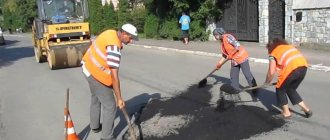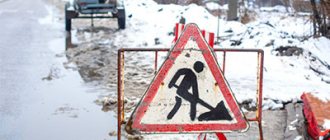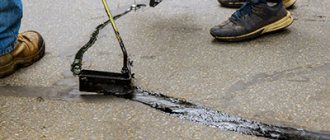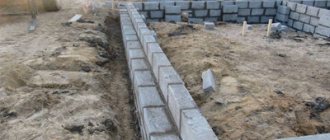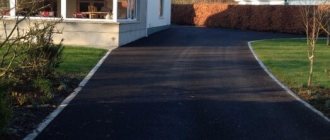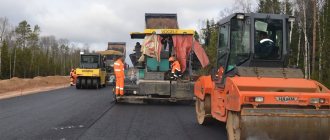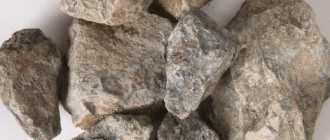Despite the fact that asphalt is a very durable and resistant coating, it, like most other materials, tends to deteriorate under the influence of various factors.
Of course, damaged areas can be restored, which is what is done in the process of pothole repair. In this case, “pothole” means not only that this type of repair is used to eliminate holes, it is also suitable for eliminating cracks and potholes.
But if we take into account what we observe in everyday life, asphalt is laid and repaired mainly in warm weather, and in Russia the cold lasts most of the year. What to do if you need to carry out repair work in cold weather? Let's sort things out in order.
Technology for laying asphalt at sub-zero temperatures
In Russia there is snow for 6-7 months, and roads need repairs regardless of the time of year. The technology of laying asphalt in winter using cast asphalt allows you to lay asphalt on snow and in rainy weather. The mixture includes sand, ground limestone, gravel and natural bitumen. When the operating temperature is 180 degrees Celsius, the molded asphalt takes the form of a hot, black plastic mass. The production technology of such material uses rubber and cellulose, which improves the quality of the product.
Laying asphalt in winter, building codes and regulations provide for the use of various plasticizers and hardeners. The agents are used to ensure that the mixture does not freeze at high sub-zero temperatures and has increased fluidity. This method allows you to seal holes when they contain dirt, water, snow, and ice. Lay asphalt at sub-zero temperatures using cold mixtures. This technology for laying asphalt in rain and snow is widely used in such areas of application as spot repairs of highways and highways.
Features of materials
Asphalt concrete is a mixture used in the construction of road surfaces, the composition of which is optimally selected based on minerals. The following minerals are used: sand, crushed stone, liquid bitumen or bitumen emulsion, mineral powder. In accordance with GOST, depending on what stone material underlies it, the mixture is classified into three types:
- Sandy.
- Gravel.
- Crushed stone.
There is another classification, which is based on the size of the mineral grains in the mixture:
- Fine-grained.
- Sandy.
- Coarse-grained.
In this case, cold mixtures can be exclusively sandy or fine-grained. There are also three more groups based on the percentage of gravel or crushed stone content (stone component):
- Group B about 30-40%.
- Group B about 40-50%.
- Group A is about 50-60%.
It is the solid “ingredients” of the asphalt mixture that, after rolling, fill all the resulting air cavities.
There is also an exclusively “hot” classification based on the residual porosity of the material, that is, according to the percentage volume of “pores” in the material after its compaction. It, as you already understood, is used only for hot mix asphalt concrete:
- Porous.
- Dense.
- Highly porous.
- High density.
Asphalt concrete mixture is used not only as a base for road surfaces, although here it has established itself as one of the most reliable and economical materials. Asphalt is used to cover squares, airfields, garden paths, private courtyards and floors in industrial premises.
Interesting to know: all types of asphalt are divided into two types: natural and artificial. Artificial ones are used everywhere. When driving around the city, you are dealing with artificially created asphalt. Natural ones are formed after the evaporation of oil and consist of its heavy residues.
Hot casting
Cast asphalt in winter differs from the standard mixture in that it contains solid bitumen, which has increased viscosity, and mineral inclusions - sand, finely structured crushed stone. Work with hot mixtures is carried out at a temperature of 200 C. Thanks to this technology, road patching can be done by laying asphalt on snow. The building material costs less than cold mixtures. Cast asphalt is easier to lay in winter due to its good plasticity. During the summer, this technique is considered a temporary emergency repair.
If we draw an analogy with ordinary hot asphalt, cast asphalt has the following positive and negative qualities:
Advantages
- After the mixture is poured, it compacts on its own when it hardens, no rolling with an asphalt roller is required;
- When testing asphalt concrete for frost resistance, it is the cast mixtures that have exceptional adhesive properties and are able to form strong adhesion to the base at sub-zero temperatures, high humidity and precipitation.
Flaws
- In order to transport a hot mixture, you will need expensive equipment that will maintain the temperature at a high level and constantly mix the material;
- Repair work on cast asphalt in winter requires considerable energy expenditure. The operating temperature during installation should be at least 200 degrees Celsius.
Cost of asphalt repair in Moscow and the Moscow region - Price per m2
| Job title | Thickness, cm. | Unit Change | Price, rub. |
| Asphalt repair - fine-grained asphalt concrete | 4-5 | m2 | 380 |
| Asphalt repair - sand asphalt concrete | 4-5 | m2 | 415 |
| Asphalt repair - coarse asphalt concrete | 4-5 | m2 | 430 |
| Asphalt repair - crushed stone-mastic asphalt concrete | 4-5 | m2 | 560 |
To view the prices for all services, go to the section Prices for all services
Mistakes that should not be made when laying asphalt in winter
There are cases when the installation technology during the cold season was not followed. In the spring, the following happens: a perfectly flat surface, after heavy equipment passes over it, turns into a bumpy road with cracks and holes. Here's what you absolutely shouldn't do when laying a road surface in winter:
- A cushion of crushed stone with sand will be equal to laying asphalt on the ground.
- Even if the pillow is well compacted during the cold season, fragments of frozen sand, snow, and ice will still remain there.
- When ground ice begins to melt in the spring, the formed cushion begins to become severely deformed. As a result, cracks and deep holes form.
Sequence of pothole repair
Repair work on asphalt pavement is carried out in the following order:
- Analysis of the condition of the road layer, pothole depth.
- Marking the boundaries of the resulting pit. Straight lines are drawn around the pothole. If the defective areas are located close to each other, they are united by one perimeter.
- Using a cutter and a jackhammer, a vertical depression is made along the outlined contour, no less than the thickness of the coating layer.
- Then damaged asphalt and debris are removed.
- The area is treated with bitumen or polymer emulsion.
- A mixture of bitumen and fine crushed stone is being laid.
- Applying a finishing layer in the form of a bitumen coating.
Pothole repairs have to be carried out for different types of roads. The flow of vehicles along the highway does not stop; traffic is blocked only in the area under repair. Warning signs are posted for this purpose.
Work should be carried out in dry weather. But the weather does not always allow road workers to comply with all requirements. The procedure is written in GOST “Roads and Streets”.
Low cost of parking lot paving
The surface is quickly and easily cleaned of emerging debris, dirt and dust, and quickly freed from snow;
Long service life allows the owner not to worry about the coating for several decades;
Fast completion of work (from the moment of development of documentation to the commissioning of the facility, a minimum amount of time passes, unless, of course, the weather interferes);
Possibility of various design solutions - the territory can be divided into zones, marked out, and if desired, you can even use colored asphalt.
Modern parking lots often act as a certain element of a company’s image and its marketing component. If desired, the customer can place on the coating various elements of stones, reflective elements, as an option, a company logo, or some kind of signs. In general, make the site original and memorable. If we are talking about a shopping center, then high-quality and, most importantly, original asphalting of a parking lot in Moscow will make your customers come back again and again.
Service life of roads according to regulatory documents
Since 2011, new rules have come into force in the Russian Federation. Restoration work is carried out once every three years, previously the period was seven years. According to the adopted law, a road passport is maintained, which indicates the history of each repaired kilometer. The road construction organization is responsible for the quality of work. All imperfections and defects are eliminated at the expense of the builders.
According to the standards, the destruction of the road surface after pothole repair is only 5 percent. The warranty period is affected by the intensity of traffic flow and operating features.
On highways of categories I and II, the coating changes with a large canvas. As a rule, traffic is blocked in one of the directions. Work must be carried out in accordance with SNiP and GOST documentation.
Regulations
Compliance with GOST for carrying out work provides for the following points:
- The provisions of GOST 9238 are responsible for the asphalt mixture.
- Maintaining temperature conditions.
- Use of crushed stone of a certain fraction. Material standards are specified in GOST 8267. Sedimentary rocks are regulated by GOST 8736.
- Requirements for bitumen are given in article GOST 22245.
SNiP contains information on standards for laying asphalt pavements. The regulatory document specifies the temperature regime for carrying out work.
Types of mixtures
For asphalt paving, compounds of various classes are used:
- Class 1 mixture for heavily loaded highways and routes, capable of withstanding heavy loads. During installation, a layer of mineral filler of 4 cm is required, which ensures resistance to heavy traffic of freight transport.
- Class 2 mixture. Suitable for sidewalks, walkways, squares. Withstands small and medium loads, has improved aesthetics, and can have large inclusions up to 25 mm.
- Class 3 mixture. It is characterized by a high level of plasticity and is used for sports fields, home and private areas. The presence of mineral inclusions up to 15 mm ensures a very tight fit of the asphalt composition.
Selecting crushed stone for the construction of a parking lot. Fast delivery
Using crushed stone to cover car parks has its advantages.
Firstly, the lower cost of the material. This is a very significant factor and is often the determining factor when choosing the material for the top coating layer. Of course, the use of asphalt or concrete makes it possible to create a stronger and more durable foundation for vehicles, but in this case the price of such construction also increases significantly. Secondly, crushed stone for parking lots is more affordable than other types of coating (especially hard surfaces). Thirdly, the use of crushed stone greatly facilitates the process of arranging a car park. In this case, the use of special equipment is not required, and all work can be carried out using simple tools.
The best option for covering car parks would be to use large fractions of this building material. Coarse crushed stone has higher strength and, therefore, a longer service life compared to small fractions. An important quality is good water permeability. A coating made of coarse crushed stone will allow water to pass through for a long time, preventing it from stagnating and the formation of puddles and dirt.
As for the material of crushed stone for parking lots, there are no significant restrictions. The use of granite, gravel, limestone, slag and recycled crushed stone is allowed.
offers crushed stone of all types and fractions for the construction of strong and durable coatings for parking lots. All building materials have the necessary certificates and are suitable for work of this nature.
If necessary, the company's managers will provide advice on any issues related to the use of crushed stone as a covering material. has its own fleet of vehicles, so delivery of purchased goods within Moscow and the Moscow region will be carried out as soon as possible.
Additional information can be obtained by calling a multi-channel telephone number or online on the website.
> Road construction and improvement
